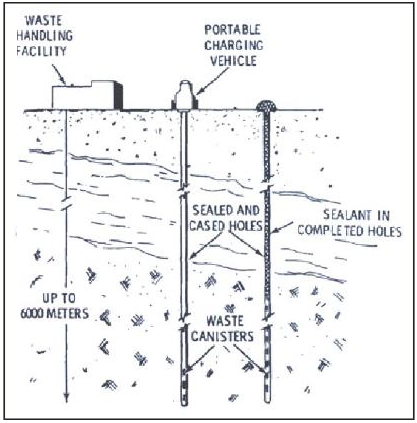(Part One of a two part article.)
I have posted many essays about the disposal of radioactive materials. In the early days of the nuclear age when the thrust was to develop nuclear weapons, nuclear waste from production was often poured or dumped in trenches and holes. Some nuclear waste was just dumped in the ocean. As time went by, better methods of storing and disposing of nuclear waste were suggested and some were tested. Spent nuclear fuel began to accumulate at nuclear power plants. It was decided that the best thing to do with nuclear waste would be to bury it deep in the ground in permanent mined geological repositories. (MGR) Germany used an old salt mine for a repository but it had to be abandoned because of ground water penetration.
A decade and millions of dollars were spent by the U.S. government on what was going to be a permanent spent nuclear fuel repository in an old salt mine under Yucca Mountain in Nevada. The project was cancelled in 2009 because of problems with ground water. An underground repository in New Mexico that was specifically intended for waste from the production of nuclear weapons was recently closed because of an explosion that released radioactive particles into the environment. It will take years and millions of dollars to reopen the repository.
In the U.S., the spent fuel pools are filling up at nuclear power reactors and temporary dry cask storage seems to be the only short term solution although there are problems with cask design. One of the proposals that I have covered was the idea of drilling sixteen thousand foot deep holes and dumping the waste in. This option which is referred to as "deep borehole disposal " (DBD) has not been done but may be the best of many alternatives.
Researchers from the University of Sheffield in Britain will present their latest findings with regard to the borehole option at the American Nuclear Society meeting next week in Charleston, South Carolina. Professor Fergus Gibb from the University of Sheffield has said, "DBD is particularly suitable for high level nuclear waste, such as spent fuel, where high levels of radioactivity and heat make other alternatives very difficult. Much of the drilling expertise and equipment to create the boreholes already exists in the oil and gas and geothermal industries. A demonstration borehole -- such as is planned in the US -- is what is now needed to move this technology forward." The Sheffield team has been researching the nuclear waste at the Hanford Nuclear Reservation in Washington State. They estimate that forty percent of the most radioactive waste at Hanford could be disposed of in a single borehole.
The biggest concern with the DBD approach is the fear that the radioactive materials might escape from the borehole. A way of covering the holes securely must be developed and thoroughly tested. Professor Gibb has suggested that a layer of granite could be melted above the waste. It would solidify and behave the same way as natural rock to seal the borehole. Professor Gibb and his team are also working on processes for surrounding the waste with special cement that can withstand the temperatures and pressures found in deep boreholes.
(Please read Part Two of this article next.)
